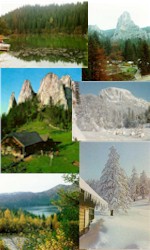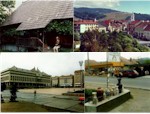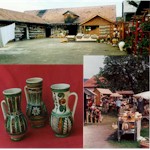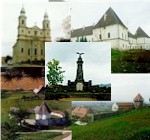COME AS A TOURIST - LEAVE AS A FRIEND
| General presentation
Population Transport Economic profile |
 |
Agriculture
Tourism Short history Return to Home Page |
 Harghita county is situated approximately in the central part of Romania, on a surface of 6,610 square km., representing 2.8% from the territory of Romania. Its relief is formed from the mountains of Gurghiu (Görgény), Hãsmas (Nagyhagymás), Ciuc (Csík) and Harghita (Hargita). From the highlands the relief descends trough volcanic plateaus to the hilly areas and depressions, where the human communities can be found. The climate is characteristic to the hilly areas, with long frosty winters and short, usually warm summers. The hydrografic network is formed by a large number of rivers and lakes. The main rivers are: the Mures (Maros) in vest, the Olt in south, the Bistrita (Beszterce) and Trotus (Tatros) in east, the Târnava Mare (Nagyküküllö) and the Târnava Micã (Kisküküllö) in south-west. The presence of the volcanic mountains in the county assures a large number of mineral water springs, around 2200. In Harghita county can be found the only lake which has volcanic origin in Romania, the "Saint Ann" lake (Lacul Sfânta Ana - Szent Anna tó) situated in picturesque site, in the volcanic crater "Ciomatu" (Csomád) at an altitude of 950 m. Another unique lake is the "Red Lake" (Lacu Rosu - Gyilkostó) which is a rarity being formed by natural obstruction. There are many types of soils: brown, yellow-brown and acid-brown. The geographical diversity of the county is emphasized also by the underground mineral resources like: the iron ore, cooper, kaolin, salt, clay, limestone, mineral water, etc. The woodlands which lay on more than 30% from the surface of the county, include many kinds of trees: larch-trees, pine-trees, beech, oak tress, lodging a rich and varied fauna composed by wild animals, such as the Carpathian bear, the brown bear, the wild boar, the marten, the wolf, the grouse, the eagle, etc. The mountain streams are rich in fishes. To the flora of the country lend variety forest fruits like strawberry, raspberry and blackberry, the mushrooms and the medicinal plants.
Harghita county is situated approximately in the central part of Romania, on a surface of 6,610 square km., representing 2.8% from the territory of Romania. Its relief is formed from the mountains of Gurghiu (Görgény), Hãsmas (Nagyhagymás), Ciuc (Csík) and Harghita (Hargita). From the highlands the relief descends trough volcanic plateaus to the hilly areas and depressions, where the human communities can be found. The climate is characteristic to the hilly areas, with long frosty winters and short, usually warm summers. The hydrografic network is formed by a large number of rivers and lakes. The main rivers are: the Mures (Maros) in vest, the Olt in south, the Bistrita (Beszterce) and Trotus (Tatros) in east, the Târnava Mare (Nagyküküllö) and the Târnava Micã (Kisküküllö) in south-west. The presence of the volcanic mountains in the county assures a large number of mineral water springs, around 2200. In Harghita county can be found the only lake which has volcanic origin in Romania, the "Saint Ann" lake (Lacul Sfânta Ana - Szent Anna tó) situated in picturesque site, in the volcanic crater "Ciomatu" (Csomád) at an altitude of 950 m. Another unique lake is the "Red Lake" (Lacu Rosu - Gyilkostó) which is a rarity being formed by natural obstruction. There are many types of soils: brown, yellow-brown and acid-brown. The geographical diversity of the county is emphasized also by the underground mineral resources like: the iron ore, cooper, kaolin, salt, clay, limestone, mineral water, etc. The woodlands which lay on more than 30% from the surface of the county, include many kinds of trees: larch-trees, pine-trees, beech, oak tress, lodging a rich and varied fauna composed by wild animals, such as the Carpathian bear, the brown bear, the wild boar, the marten, the wolf, the grouse, the eagle, etc. The mountain streams are rich in fishes. To the flora of the country lend variety forest fruits like strawberry, raspberry and blackberry, the mushrooms and the medicinal plants.
 The population of Harghita county - at the end of 1994 - was 348,499 persons, from which 48.6% living in urban settlements and 54.4%. From the inhabitants 85% are Hungarians, 14% Romanians and 1% other nationalities. According to their religion, 65% are Catholics, 13% Orthodox, 13% reformed, 7% Unitarian and 2% of other religions. There are 9 Urban settlements, Miercurea Ciuc (Csíkszereda) is the county-town, which together with Odorheiu Secuiesc (Székelyudvarhely) are the two most important economical centers of the county. The other towns are: Gheorgheni (Gyergyószentmiklós), Toplita (Maroshévíz), Bãlan (Balánbánya), Cristuru-Secuiesc (Székelykeresztúr), Vlãhita (Szentegyháza), Borsec (Borszék) and Bãile-Tusnad (Tusnádfürdö). The rural population lives in 285 villages and communities. Communities are: Atid (Etéd), Avrãmesti (Szentábrahám), Bilbor (Bélbor), Brãdesti (Fenyéd), Cãpîlnita (Kápolnásfalu), Ciucsîngeorgiu (Csíkszentgyörgy), Ciumani (Gyergyócsomafalva), Cîrta (Csíkkarcfalva), Corbu (Gyergyóholló), Corund (Korond), Dãnesti (Csíkdánfalva), Dealu (Oroszhegy), Ditrãu (Gyergyóditró), Dîrjiu (Székelyderzs), Feliceni (Boldogfalva), Frumoasa (Csíkszépvíz), Gãlãutas (Galócás), Joseni (Gyergyóalfalu), Lãzarea (Gyergyószárhegy), Lueta (Lövéte), Lunca de Jos (Gyimesközéplok), Lunca de Sus (Gyimesfelsölok), Lupeni (Farkaslaka), Mãrtinis (Homorodszentmárton), Meresti (Homorodalmás), Mihãileni (Csíkszentmihály), Mugeni (Bögöz), Ocland (Oklánd), Pãuleni-Ciuc (Csíkpálfalva), Plãiesii de Jos (Kászonaltíz), Praid (Parajd), Remetea (Gyergyóremete), Sãcel (Románandrásfalva), Sãrmas (Salamás), Secuieni (Újszékely), Siculeni (Csíkmadéfalva), Sîncrãieni (Csíkszentkirály), Sîndominic (Csíkszentdomokos), Sînmartin (Csíkszentmárton), Sînsimion (Csíkszentsimon), Subcetate (Várhegy), Suseni (Gyergyóújfalu), Simonesti (Siménfalva), Tulghes (Gyergyótölgyes), Tusnad (Tusnád), Ulies (Kányád), Vãsag (Székelyvarság), Voslobeni (Gyergyóvasláb), Zetea (Zetelaka).
The population of Harghita county - at the end of 1994 - was 348,499 persons, from which 48.6% living in urban settlements and 54.4%. From the inhabitants 85% are Hungarians, 14% Romanians and 1% other nationalities. According to their religion, 65% are Catholics, 13% Orthodox, 13% reformed, 7% Unitarian and 2% of other religions. There are 9 Urban settlements, Miercurea Ciuc (Csíkszereda) is the county-town, which together with Odorheiu Secuiesc (Székelyudvarhely) are the two most important economical centers of the county. The other towns are: Gheorgheni (Gyergyószentmiklós), Toplita (Maroshévíz), Bãlan (Balánbánya), Cristuru-Secuiesc (Székelykeresztúr), Vlãhita (Szentegyháza), Borsec (Borszék) and Bãile-Tusnad (Tusnádfürdö). The rural population lives in 285 villages and communities. Communities are: Atid (Etéd), Avrãmesti (Szentábrahám), Bilbor (Bélbor), Brãdesti (Fenyéd), Cãpîlnita (Kápolnásfalu), Ciucsîngeorgiu (Csíkszentgyörgy), Ciumani (Gyergyócsomafalva), Cîrta (Csíkkarcfalva), Corbu (Gyergyóholló), Corund (Korond), Dãnesti (Csíkdánfalva), Dealu (Oroszhegy), Ditrãu (Gyergyóditró), Dîrjiu (Székelyderzs), Feliceni (Boldogfalva), Frumoasa (Csíkszépvíz), Gãlãutas (Galócás), Joseni (Gyergyóalfalu), Lãzarea (Gyergyószárhegy), Lueta (Lövéte), Lunca de Jos (Gyimesközéplok), Lunca de Sus (Gyimesfelsölok), Lupeni (Farkaslaka), Mãrtinis (Homorodszentmárton), Meresti (Homorodalmás), Mihãileni (Csíkszentmihály), Mugeni (Bögöz), Ocland (Oklánd), Pãuleni-Ciuc (Csíkpálfalva), Plãiesii de Jos (Kászonaltíz), Praid (Parajd), Remetea (Gyergyóremete), Sãcel (Románandrásfalva), Sãrmas (Salamás), Secuieni (Újszékely), Siculeni (Csíkmadéfalva), Sîncrãieni (Csíkszentkirály), Sîndominic (Csíkszentdomokos), Sînmartin (Csíkszentmárton), Sînsimion (Csíkszentsimon), Subcetate (Várhegy), Suseni (Gyergyóújfalu), Simonesti (Siménfalva), Tulghes (Gyergyótölgyes), Tusnad (Tusnád), Ulies (Kányád), Vãsag (Székelyvarság), Voslobeni (Gyergyóvasláb), Zetea (Zetelaka).
An over 300 km railway network crosses Harghita county in different directions, making easier the contact other counties from vicinity. The total of the national and county roads is over 1,500 km. The length of railways is 215 km. The density of the communication lines is lower in comparison with other counties because of the mountainous relief.
 The economy of the county through an intensive restructuring process. In the last two years the economy has shown a slight stabilization tendency, the production has grown as well as the exportation. The liveliness of the investments and the slight decrease of the inflation rate are all positive signs. The private sector which appeared after 1990, composed by a large number of small and medium-sized enterprises, represents an important segment of the economy and shows a continuos growth. At the end of 1994, there were 5,150 enterprises registered in the Register of Commerce, from which 4,807 were private ones. The foreign capital represents 16.30% from the total amount invested in Harghita county. The main industrial branches are directly related to the natural ground and underground resources. Am important ratio of the industry is occupied by the extractive sector (iron, cooper, kaolin, salt, mineral water, ...etc.), the wood felling and wood processing sector, by the light industry, the food processing sector and the engineering industry. There are also present in the county the manufacturing industry, the folk art and key sectors of the economy like tourism and agriculture.
The economy of the county through an intensive restructuring process. In the last two years the economy has shown a slight stabilization tendency, the production has grown as well as the exportation. The liveliness of the investments and the slight decrease of the inflation rate are all positive signs. The private sector which appeared after 1990, composed by a large number of small and medium-sized enterprises, represents an important segment of the economy and shows a continuos growth. At the end of 1994, there were 5,150 enterprises registered in the Register of Commerce, from which 4,807 were private ones. The foreign capital represents 16.30% from the total amount invested in Harghita county. The main industrial branches are directly related to the natural ground and underground resources. Am important ratio of the industry is occupied by the extractive sector (iron, cooper, kaolin, salt, mineral water, ...etc.), the wood felling and wood processing sector, by the light industry, the food processing sector and the engineering industry. There are also present in the county the manufacturing industry, the folk art and key sectors of the economy like tourism and agriculture.
On the 92,735 ha arable land are grown different crops according to the geographical placement. The most important is the potato, the specific vegetal crop of the region, but there are others too, like the sugar beet, the barley the rye and the oat in a lower percentage. The county has over 300,000 ha pastures, assuring excellent conditions for live-stock raising, another main branch of the agriculture in Harghita county.
 Harghita county has important and valuable resources in the field of tourism. As a result of the variety of the surface and the wonderful sights, the existence of more than 160 cultural monuments, also world-famous spas and mountain resorts like: Borsec (Borszék), Bãile-Tusnad (Tusnádfürdö) with Saint Ann Lake (Lacul Sfânta Ana - Szent Anna tó), Izvorul Mures (Marosfö) and Lacu Rosu (Red Lake - Lacu Rosu - Gyílkostóoacute), every year more and more tourists visit the county. Springs of mineral waters, sulfurous mophettas, mud-bathes, therapeutically peat's and others constitute very valuable richness which could be used more efficiently in the future. The privatization, the improvement of the infrastructure and a good publicity would help considerably.
Harghita county has important and valuable resources in the field of tourism. As a result of the variety of the surface and the wonderful sights, the existence of more than 160 cultural monuments, also world-famous spas and mountain resorts like: Borsec (Borszék), Bãile-Tusnad (Tusnádfürdö) with Saint Ann Lake (Lacul Sfânta Ana - Szent Anna tó), Izvorul Mures (Marosfö) and Lacu Rosu (Red Lake - Lacu Rosu - Gyílkostóoacute), every year more and more tourists visit the county. Springs of mineral waters, sulfurous mophettas, mud-bathes, therapeutically peat's and others constitute very valuable richness which could be used more efficiently in the future. The privatization, the improvement of the infrastructure and a good publicity would help considerably.
 The territory of Harghita county has been populated already from time immemorial. The old settlements discovered in the area, prove the presence of different material and spiritual cultures along the centuries. During the X.-Th. and the XI.-Th. centuries settled down here the Székelys (Szeklers). The have spoken the Hungarian language and had the mission to defend the borders of Transylvania. In exchange they were let to guide and organize themselves according to their own laws. The Tartars have overrun the county several times, in 1241, 1661, and in 1694, killing many people and burning down everything. The existence of many settlements is mentioned for the first time in 1332-1333. Also from this period is dated the presence of some Romanian communities in the area. Numerous wars shook the earth of the county. The Székelys had to fight against the Turks for years and than against the Austrian oppression for their independence and autonomy, in 1690, 1764 and in 1848 with the occasion of great revolution. Transylvania was part of Hungary till the end of 1918. Since 1919, started a new phase in the history of the region and in the integration of the Székelys into the political and economical life of Romania.
The territory of Harghita county has been populated already from time immemorial. The old settlements discovered in the area, prove the presence of different material and spiritual cultures along the centuries. During the X.-Th. and the XI.-Th. centuries settled down here the Székelys (Szeklers). The have spoken the Hungarian language and had the mission to defend the borders of Transylvania. In exchange they were let to guide and organize themselves according to their own laws. The Tartars have overrun the county several times, in 1241, 1661, and in 1694, killing many people and burning down everything. The existence of many settlements is mentioned for the first time in 1332-1333. Also from this period is dated the presence of some Romanian communities in the area. Numerous wars shook the earth of the county. The Székelys had to fight against the Turks for years and than against the Austrian oppression for their independence and autonomy, in 1690, 1764 and in 1848 with the occasion of great revolution. Transylvania was part of Hungary till the end of 1918. Since 1919, started a new phase in the history of the region and in the integration of the Székelys into the political and economical life of Romania.
Responsibility for the text provided above lies with the: Harghita County Council
Last Updated: Friday, June 19, 1998
Web Master: Árpád Fábián Kovács
http://www.magyar.org/kovacs/
http://www.wizard.net/~hungary/